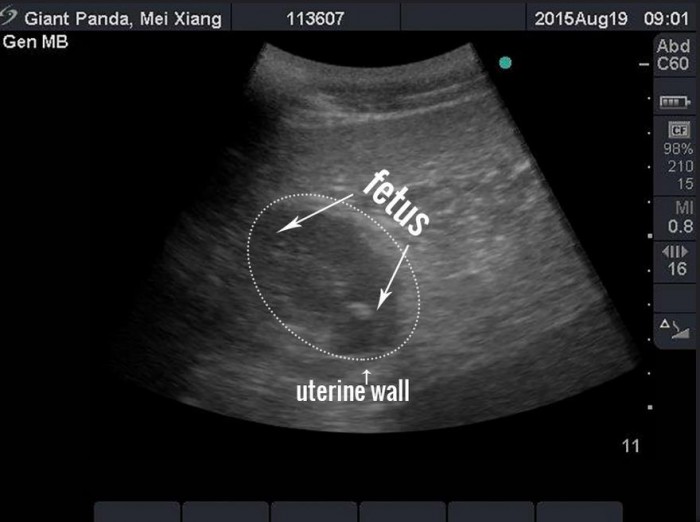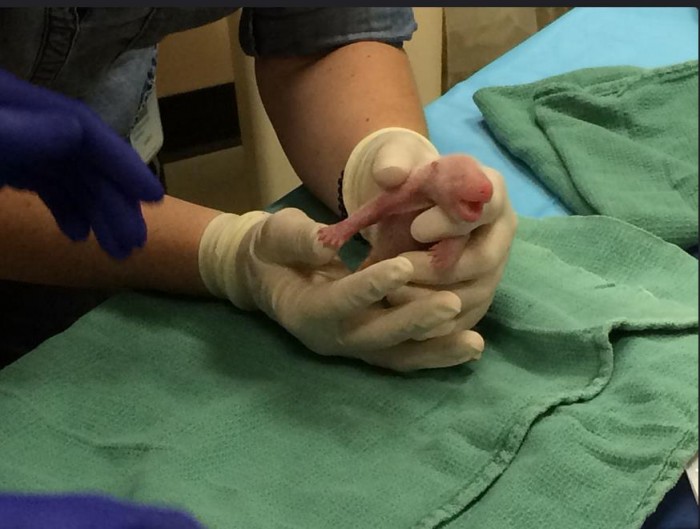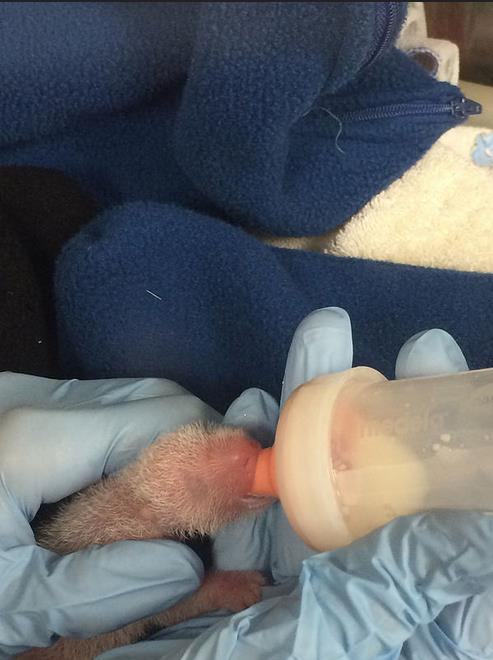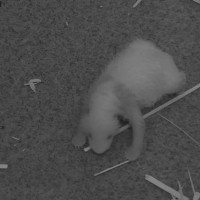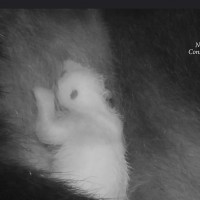#PandaStory
Unless you spent August marooned on a desert island talking to a volleyball (in which case, welcome back–nice tan), you’re probably aware that we’ve experienced a bit of excitement—one might even say, pandamonium—at the National Zoo recently.
The birth of a giant panda under human care is not something that happens accidentally. A dedicated and indefatigable team of reproductive scientists, veterinarians and animal care specialists have been with the Zoo’s female giant panda Mei Xiang every step of the way.
April 26 – 27: Artificial insemination
Reproductive scientists from the Smithsonian’s national Zoo and Conservation Biology Institute artificially inseminated Mei Xiang using semen collected from both the Zoo’s male giant panda Tian Tian and from a giant panda named Hui Hui at the China Conservation and Research Center for the Giant Panda in Wolong. A cub by Mei Xiang and Hui Hui would be very genetically valuable, helping to preserve the genetic diversity of the panda population in human care. (Read more about how SCBI scientist Caitlin Burrell transported Hui Hui’s sperm from China here >>)
Mei Xiang has given birth to two surviving cubs: Tai Shan and Bao Bao. Tai Shan was born July 9, 2005; he now lives in China. Bao Bao was born Aug. 23, 2013. She will live at the Zoo until she turns 4 when she will also go to live in China and, eventually enter the giant panda breeding program. Both Tai Shan and Bao Bao were born as the result of artificial inseminations using sperm collected from Tian Tian.
July 20: Hormone levels rise
SCBI scientists confirmed a secondary rise in Mei Xiang’s urinary progesterone levels, signaling that she would either have a cub or experience the end of a pseudopregnancy within 30 to 50 days.
August 19: Pregnancy confirmed
For the first time, veterinarians detected what they believe is a developing fetus during an ultrasound performed on Mei Xiang. Based on the size of the fetus, which is about four centimeters, veterinarians estimate that Mei Xiang could give birth within a week to 10 days. During previous pregnancies and since August 7, Meoi Xiang has declined to participate in ultrasounds at this stage, so it was a surprise when she responded to the panda keepers’ calls.
August 22: Mei Xiang gives birth to twin cubs
The panda team began preparing for a birth when they saw Mai Xiang’s water break at 4:32 p.m. and she was already having contractions. She gave birth to a cub at 5:35 p.m. Mei Xiang reacted to the cub by picking it up and cradling it. Mei Xiang and the cub are being monitored via the Zoo’s panda cams. The panda team will perform a neonatal exam on the cub when they are able to retrieve it.
A second cub was born at was born at 10:07 p.m. Shortly after the second birth, a panda team of three keepers retrieved one of the cubs per the Zoo’s Giant Panda Twin Hand-Rearing protocol. The cub was placed in an incubator and cared for by veterinarians and panda keepers.
The panda team believes the first cub they retrieved was the second cub born at 10:07 p.m. This cub continued to vocalize very well and appeared healthy. It weighed 138 grams at birth. The team fed the cub three times overnight, receiving 30 to 40 percent of the serum it was hand-fed. The nursing bouts were short but the team considers them successful. The goal was to give the cub antibodies (colostrum alternative) as it has not yet nursed on Mei Xiang. This cub has now been marked with a little green food coloring on its left hip.
August 23: Caring for the cubs
At approximately 6:30 a.m., the team was able to swap cubs. This cub, believed to be the first born, weighs 86.3 grams. It is vocalizing very well and appears strong. The panda team does not plan to feed this cub as it will be switched back to Mei Xiang in a couple of hours. However, they are prepared to feed the cub if it demonstrates certain behaviors.
The National Zoo is one of a few zoos with expert nutritionists on staff. They have prepared formula and trained for this scenario. Formula ingredients include water; human baby formula; and puppy formula. The ingredients are mixed together and strained to omit clumps. The concern now is whether Mei Xiang will allow the panda team to consistently swap the cubs. The team developed a few different strategies and will continue to try different methods of swapping and hand-rearing. A lot will be dictated by Mei Xiang.
The panda team will alternately swap the cubs, allowing one to nurse and spend time with Mei Xiang while the other is being bottle fed and kept warm in an incubator. The primary goal for the panda team is for both cubs to have the benefit of nursing and spending time with their mother. It is too early to guess about when the cubs will be placed together.
Giant pandas give birth to twins approximately 50 percent of the time. This is only the third time a giant panda living in the United States has given birth to twins. There are only two other female giant pandas who have successfully reared twins and it required a lot of human support.
Big sister Bao Bao celebrated her second birthday with a frozen fruitsicle cake comprised of some of Bao Bao’s favorite treats, including honey, apple juice, apple sauce, bamboo, carrots and beet juice.
August 26: A sad loss
The smaller of the two giant panda cubs born Aug. 22 died shortly after 2 p.m. The panda team rotated both cubs in the past 24 hours allowing each to benefit from spending time with their mother Mei Xiang. The smaller cub was with Mei Xiang from about 2 p.m., Aug. 25, until the morning of Aug. 27. When the panda team swapped the cubs, they assessed the little cub and had concerns because it had not increased in weight, appeared weaker and exhibited possible respiratory issues.
Developed from the experience and success of Chinese partners and other zoos, the hand-rearing protocol provided the panda team with several strategies to manage twin cubs. Swapping the cubs between mother and hand-rearing is a proven method that enables zoo staff to best care for twins in the event that the mother cannot manage two cubs, which was the case with Mei Xiang. When swapping the cubs became difficult, the panda team had in their possession the smaller cub, which was losing weight, needed calories and energy, and was at risk if he remained away from Mei Xiang for a prolonged period of time. The cub’s best option for survival was to receive supplemental feedings via bottle and tube, but both techniques present risks. The team witnessed some regurgitation of food during one feeding, so the cub was started on antibiotics as a preventative measure.
The Zoo’s pathologists will perform a necropsy (animal autopsy) on the 4-day-old cub. A final pathology report will provide more information in the next few weeks. The veterinary and pathology team will continue to work closely during the ongoing histological evaluation.
At the time of death, the cub weighed 79.8 grams, about 2.8 ounces. The mortality rate for panda cubs in their first year in human care is 26 percent for males and 20 percent for females. At the birth of the second cub, Mei Xiang demonstrated that she was challenged to care for both cubs, but she did not indicate a preference for one cub over the other. The collective scientific knowledge about giant panda mothers is that they are best able to care for one cub at a time.
The panda team continues to monitor Mei Xiang and the larger cub via the Panda Cams. They are encouraged that this cub appears to be strong and robust, and that it is behaving normally, urinating and defecating. At last weigh-in, the cub weighed 137.7 grams. Despite these encouraging signs, the team continues to closely monitor both Mei Xiang and her cub around the clock, as the cub is still vulnerable and the risk remains high.
Overnight, it was evident to panda keepers and veterinarians that our healthy panda cub was active and nursing appropriately throughout the night. Mother Mei Xiang is showing proper maternal care which includes short sleep cycles and adjusting the tiny cub in her arms for better positioning and grooming.
August 28: Sex and paternity of cubs revealed
Scientists at the Smithsonian Conservation Biology Institute’s Center for Conservation and Evolutionary Genetics confirmed that the giant panda cub born Aug. 22 is male. A paternity analysis showed that Tian Tian is the cub’s father. Scientists also confirmed the deceased cub also was male and sired by Tian Tian. The cubs were fraternal twins.
To determine gender, Zoo scientists sequenced a short fragment of the zinc finger protein gene. The method was developed by SCBI scientists and veterinarians and previously determined to reliably identify the sex of pandas.
For the paternity tests they compared genotype profiles of DNA samples from the cubs to profiles from Mei Xiang, Tian Tian and Hui Hui. As a result of previous conservation research, SCBI’s Center for Conservation and Evolutionary Genetics had blood samples from Mei Xiang and Tian Tian on hand. They compared the DNA of the cubs’ cheek cells to the adult pandas’ DNA samples for the tests. Veterinarians collected the cheek-cell samples with a small swab during a preliminary health check Aug. 24.
Based on the findings of the necropsy performed on the smaller cub that died Aug. 26, Zoo pathologists and veterinarians determined the most likely cause of death to be complications associated with aspiration of food material into the cub’s respiratory system resulting in the development of pneumonia.
- The surviving cub is growing and thriving under Mei Xiang’s care and the watchful eyes of the panda team at the National Zoo.
- The surviving cub is growing and thriving under Mei Xiang’s care and the watchful eyes of the panda team at the National Zoo.
September 3: Health check
Mei Xiang left her den Saturday afternoon to eat and drink. She ate more bamboo than during her previous excursions away from the den, which is normal. Keepers expect Mei Xiang to gradually spend more time away from the den eating and drinking as the cub grows. While Mei Xiang was eating, veterinarians and keepers took the opportunity to give the cub another quick checkup. He weighed 409.6 grams, which was 119 grams more than he weighed on Sept. 2. His 297 percent weight increase is normal for a cub his age. Cubs at this stage usually gain between 40 and 55 grams per day. Veterinarians also listened to his heart and lungs, which all sounded normal. His eyes are still closed, which is normal. Cubs’ eyes generally open when they are 6 to 8 weeks old. He also had a full belly at the time of the exam and appeared to be healthy.
The Zoo will continue to provide daily updates on Mei Xiang and the cub through its @SmithsonianZoo Instagram account using #PandaStory and through the Giant Panda e-newsletter. Of course, the Giant Panda Cams are always on.
BONUS! Research scientist Bill McShea, the Zoo’s so-called “panda guy,” dispels some common myths about pandas, including the idea that they are incompetent breeders. In the wild, they do just fine, thank you very much. Read more from the Washington Post. >>
Posted: 1 September 2015
